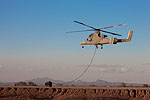2 unmanned cargo helos vie for lift platform contract
 MARINE CORPS BASE QUANTICO, VA. — Boeing’s H-6U Little Bird, a staple of the special operations community, is in the running for the Marine Corps’ future unmanned lift platform.
MARINE CORPS BASE QUANTICO, VA. — Boeing’s H-6U Little Bird, a staple of the special operations community, is in the running for the Marine Corps’ future unmanned lift platform.
The traditionally manned Little Bird helicopter, which is used for a variety of missions, including Special Forces raids, will be evaluated here in February, putting it in a head-to-head competition with Lockheed Martin/Kaman’s K-MAX helicopter.
The two platforms will duke it out to win a contract for the Autonomous Aerial Cargo Utility System program.
Two K-MAX helicopters began operating in Afghanistan in late 2011, but one crashed June 5 while resupplying Marines, so only one is operating down range for the time being.
Boeing, operating as a subcontractor for Aurora Flight Sciences, is now flying the Little Bird near Manassas with a pilot on board, but not controlling the aircraft.
Having the pilot option helps the companies comply with Federal Aviation Administration regulations, said Michael Sahag of Boeing, head of business development for unmanned airborne systems.
Boeing has been flying the helicopter unmanned since 2004. It has completed takeoffs and landings on ships at sea, including on a commercial ship in July, and during a test with the French navy in October 2012.
The Little Bird has an endurance of about 12 hours with a limited payload, and can carry up to 25,000 pounds, including weapons such as Hellfire rockets and other intelligence, surveillance and reconnaissance mission packages.
The K-MAX is capable of carrying up to about 6,000 pounds of cargo, and once flew 30,000 pounds of cargo over the course of six missions.
Terry Fogarty, general manager of the Kaman UAS product group, confirmed that the Marine Corps plans on keeping at least one K-MAX in theater until at least 2014, when the last combat Marines are expected to leave Afghanistan.